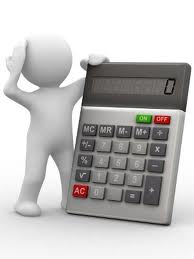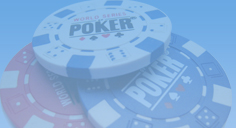How to calculate the Poker Odds of Making Your Hand
It is critical that you are able to calculate the odds of you making your hand, if not exactly at least to enough of a degree that you know whether to play on in the hand. Every time you play a hand, you will be faced with decisions that should be odds based. Getting these decisions wrong can be a costly mistake. Being able to work out odds will allow you to better mitigate your risk.
Simplistically, every time you enter a pot, you are risking your money.  Understanding your risk exposure Vs the reward is an important principle. In simple terms, you want to risk chips into pots where the rewards justify the risk. If you were playing in a tournament and were faced with an all-in situation and you had a 5% chance of winning the hand, would you do it? The simple answer would be no. You would only win once every 20 hands, so this wouldn't be a smart play. If you were a 90% favorite, you would (should) absolutely play - even if there is a 1 in 10 chance your day is done.
Understanding your risk exposure Vs the reward is an important principle. In simple terms, you want to risk chips into pots where the rewards justify the risk. If you were playing in a tournament and were faced with an all-in situation and you had a 5% chance of winning the hand, would you do it? The simple answer would be no. You would only win once every 20 hands, so this wouldn't be a smart play. If you were a 90% favorite, you would (should) absolutely play - even if there is a 1 in 10 chance your day is done.
Ok, let's take a closer look. There are 52 cards in a deck of cards. Regardless of how many people are at your table you will be able to see a number of visible cards (which will be your hand and the board) which will leave those that won't be visible - these will be all the face down cards, those still in the deck (and the burn cards). You can use this information to your advantage as you will know what cards are left in the deck. So what does that give me? It actually gives you a lot of information.
Calculation of Outs
It is important that you understand the relevance and importance of your 'Outs'. Outs are the cards that could be dealt that could make you a hand that is stronger than what you think your opponent has. Let's assume your opponent only plays premium hands and is playing aggressively - you put him on a big pair or AK / AQ. The flop and turn show 2-7-9-10. You hold A-8, so any J or 6 will make you the straight. The J's and 6's are considered outs as they will improve your hand into a likely winning hand (assuming your read on your opponent is right). Even if you think your opponent has Aces, then your flush would likely win the hand. There are potentially 4 x Jacks and 4 x 6's that could make you that winning hand. That's 8 cards or 8 outs. There could be more if there were flush possibilities but lets assume there aren't. Also need to remember that there are quite possibly far less than 8 outs as we are assuming that no other player has one in their hand.
Turning 'Outs' into useable odds
Now that we know the outs, we need to understand how to get odds that we can use to aid our decision making. Let's assume that there were only 8 outs. We next need to understand how many cards are left to come. Remember there are 52 cards in the deck.  You have another 2 in your hand, so 50. There are 4 cards on the board, leaving 46. So out of the 46 cards, 8 will win you the hand and 38 will make you lose. This can be expressed as 38 to 8 or just under 5-1. If you played the hand from here 5 times (or every 4.75 times to be precise), you would only come out a winner once. And this is at best as it assumes that no J's or 6's are held by any other player. Remember to count the burn cards also, assuming there are any.
You have another 2 in your hand, so 50. There are 4 cards on the board, leaving 46. So out of the 46 cards, 8 will win you the hand and 38 will make you lose. This can be expressed as 38 to 8 or just under 5-1. If you played the hand from here 5 times (or every 4.75 times to be precise), you would only come out a winner once. And this is at best as it assumes that no J's or 6's are held by any other player. Remember to count the burn cards also, assuming there are any.
There are a number of factors that would come into play. Now that you know you are 5-1 against to win the hand, you need to look at what you can win. If there is $200 in the pot and your opponent bets $20. To see the last card you would need to call the $20. You would be risking $20 to win $200, so would be getting 10-1 on your money compared to the 5-1 you are to hit your hand. You should call.
This would be one of the easier decisions you have to make. In short, where the pot odds are greater than the odds of making your hand, you should call, as you will make money in the long run. Of course, you will also lose your fair share of these hands but anything even money (pot odds = odds of making your hand) or better, the correct play is to call.
How do i calculate all this in a split decision?
And a fair question it is. Especially if you are online, you will not have a great deal of time to make decisions, as things happen a lot faster than in live games. There are a few shortcuts that will get you to the same decision. Firstly, you could use any number of tools that can be used to analyse the game in poker rooms. When it comes to poker, there is a little more you can do to minimise your loses. In any game of Hold'em, let's look at two scenarios. Either you are on the flop and there are two cards to come, or you're on the turn and there is just a single card to come.
Scenario #1 - Ok, you're on the flop and, sticking with the same example, you have 8 outs, and two cards to come. Simply multiply your outs by 4 and you will have a rough percentage, in this case 32%. It isn't as accurate this way, but as a rule of thumb, it will give you what you need to aid the decision.
Scenario #2 - If there is only one card to come, instead of multiplying your outs by 4, you would multiply it by 2 (there are half the number of cards to come there were on the flop). In this example, you would have 8 outs, so 8x2 = 16%.
Some Quick Odds
Trips: To turn your pair into Three-of-a-Kind on the turn, you will only do this 4.3% of the time. To hit your trips on the river - again 4.3%. From the flop to catch your set would be done 8.4% of the time. These stats should emphasize the fact that you shouldn't commit too many chips trying to catch trips as you will do so less than 1 in 8 times. You will need to play sensibly and try to get cheap flops.
Flush: If you hold a four flush, the odds of catching it on the turn are 19.1%, on the river is 19.6%. Catching it on the turn or the river is 35.0%.
Straight Flush - If you have both a flush and straight draw you have 15 outs. This equates into a 31% of hitting on the turn and 32.6% on the river.
Open-Ended Straight: Odds of catching your card on the turn, 17.0%. On the river, 17.4%. On the turn or the river, 31.5%. (See Open-Ended Straight).
Gutshot Straight: Catching your card on the turn, 8.5%. Catching your card on the river, 8.7%. Catching it on the turn or the river, 16.5%. (See Gutshot Straight).



Popular Top-Lists
Recommended Visit













 Top UK Poker Options
Top UK Poker Options